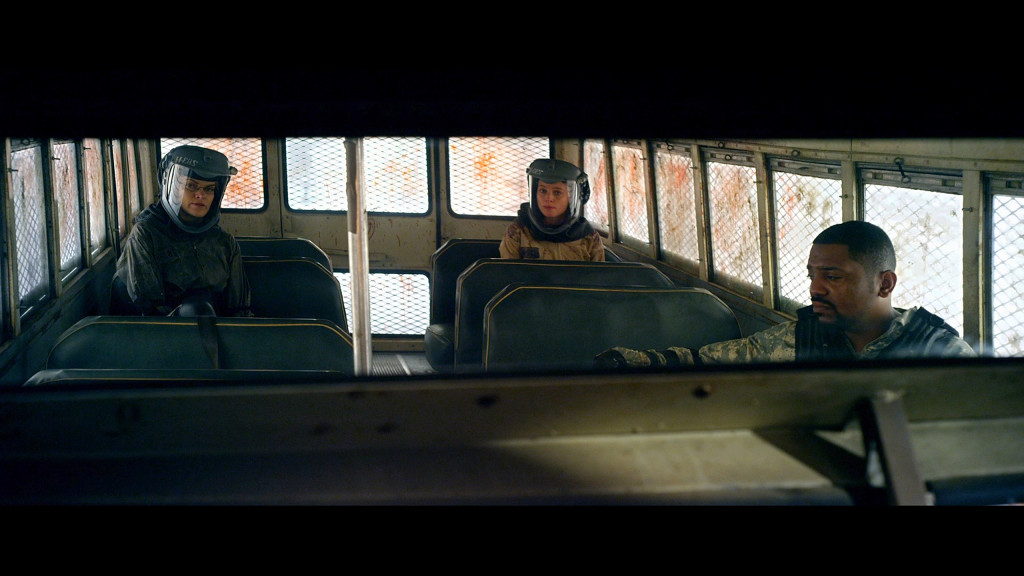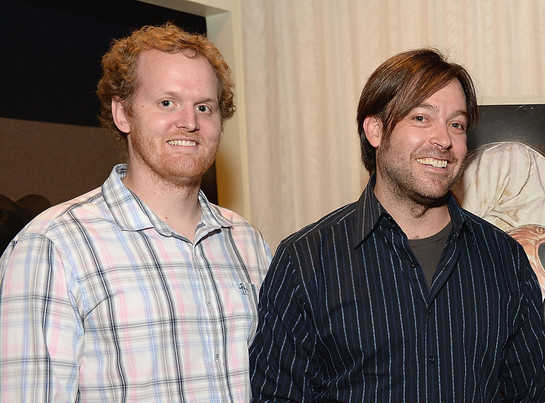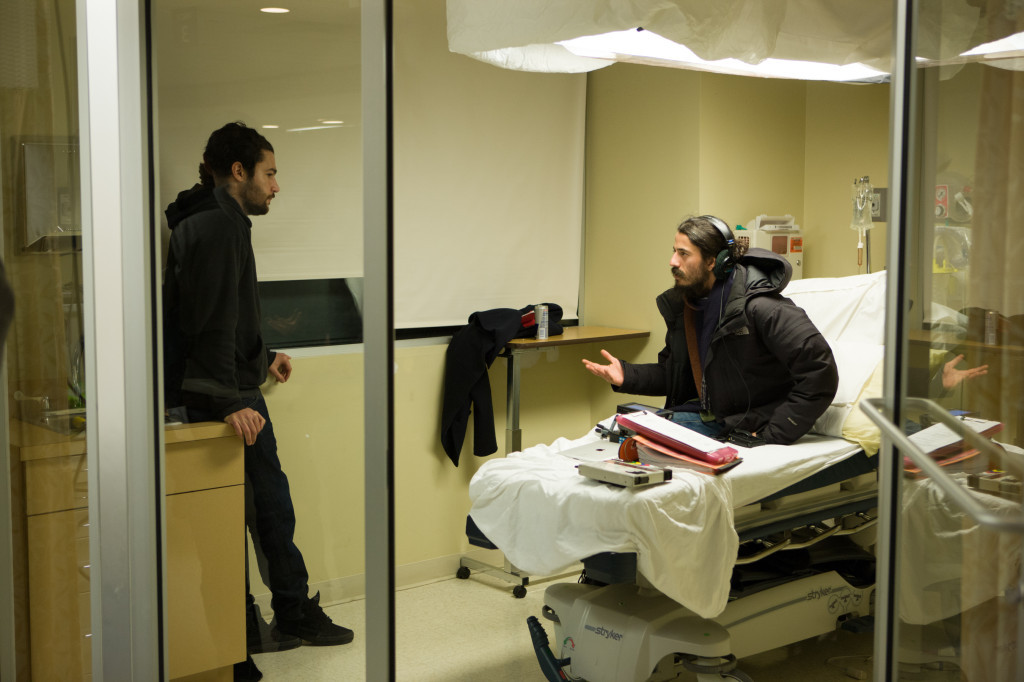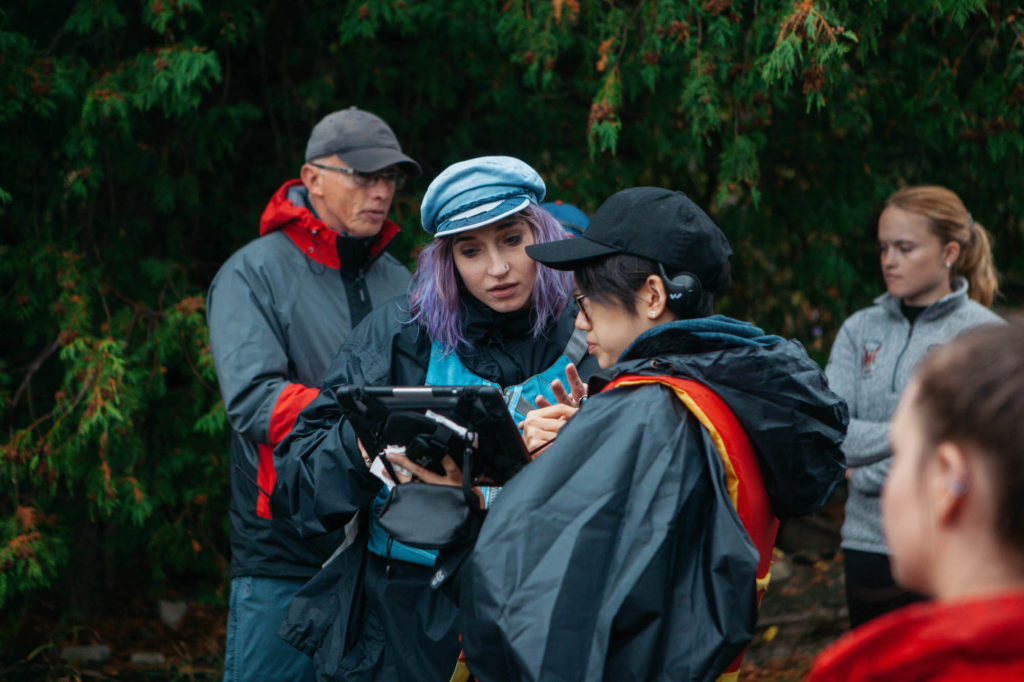While studying for their master’s degrees in 2006, CalArts classmates JOHN SUITS and GABRIEL COWAN wanted to take the plunge and make their first feature film. Their film school professors thought that was a bad idea, suggesting they instead get an internship on a big production or at a studio. But Suits and Cowan were undeterred and made their movie anyway. They wrote a script in nine days, shot the feature (Breathing Room) over the course of a week, and ended up with a successful festival run and a distribution deal.
Ten years and twenty(!) feature films later, Suits and Cowan are still producing partners through their company New Artists Alliance, having collaborated on award-winning films such as Cheap Thrills, Bad Milo!, Loitering With Intent, and Courteney Cox’s directorial debut Just Before I Go. Their newest film, PANDEMIC, will be released by XLrator Media on April 1 in theaters and iTunes and VOD on April 5.
Pandemic offers a POV ride through the fallout of an apocalyptic virus that has overtaken the country, and a Los Angeles-based extraction team (Rachel Nichols, Alfie Allen, Missi Pyle, and Mekhi Phifer) tasked with rescuing survivors. We had a chance to talk to Pandemic director/producer John Suits and producer Gabriel Cowan about their past indie collaborations and this new first-person feature.
——
COLIN McCORMACK: Hey guys, so for the SAGindie blog – just to give you a gauge of our audience – we have actors, actor/filmmakers, some first-time filmmakers–
GABRIEL COWAN: We know SAGindie well because we’ve tended to go to the SAGindie website many times for all of our contracts to reference. We as independent filmmakers are on your site all the time.
CM: Well that’s very flattering to hear! I’ll play this [recording] for my boss so she knows we’re doing our job.
So I’ll start first with John about finding the screenplay for Pandemic [written by Dustin T. Benson and originally titled Viral]. I read that you found it on The Blood List and The Hit List, which I would assume would instill some hope for any screenwriters plugging away at spec scripts out there. But what are some other ways you discover the scripts that you want to pursue as either a director or producer?
JOHN SUITS: Gabe and I have been making movies together now for about ten years and it’s changed over time, but we’ve done things like looking on Mandy[.com], even at some point putting posts on Craigslist. But I think more lately it’s been looking at The Black List website [and] reading a bunch of scripts in the genre we’re looking for. And we also go to places like The Blood List, where we looked at a bunch of the scripts of the moment, and it was in 2013 or 2014 when we first started talking to Dustin about the [Pandemic] script. And we worked with him on it for a while. But to answer the question, [there are] all different ways we go about it. Sometimes things are submitted to our agencies. We’re just trying to find the best material.
CM: And was the Pandemic screenplay originally written in the first-person-shooter style, or did you bring that element on as the director?
JS: Yes, it was originally written in the first-person-shooter style. And it actually took place in New York and was also continuous. So the first script was one shot; it was ninety minutes in real-time, which is a really cool concept but it seemed to us that we could tell more story if we had it take place over a day. And we developed it from there with Dustin, but it was a really fun read and it definitely caught both of our attention.
CM: What was the camera-rig-testing process like with your cinematographer [Mark Putnam]? Were you just running around with cameras on helmets trying to figure out what would look good but also be practical?
JS: Yeah, with Gabe we went to [camera rig specialists] Radiant Images. They had done this short film where they had supplied [a rig]– what was that called, Gabe? Do you remember?
GC: That cool SXSW short?
JS: Yeah.
GC: Random Stop, with the actor Brian Krause.
JS: Yeah. Gabe maybe saw it first and sent it to me and I was like, Yes, this is the sort of visual style we’re looking for. So we saw that Radiant Images had helped them out, so we contacted Radiant Images and they were awesome with us. We went over there [for] multiple, multiple days testing all sorts of rigs and all sorts of different things to figure out how to find the rig that was [right]. We ended up using seven different cameras and three different rig systems because for action we shot most of it with a RED. But that is a 25-pound rig someone would have to wear on their head, so during the action sequences obviously you can’t have 25 pounds on your head. But we liked the RED because it gave us more range and movement so it doesn’t feel like shaky-cam but more like how the eye experiences stuff.
CM: Like you said, you guys have been making movies together for ten years and I think this is your eighteenth or nineteenth feature?
GC: Twentieth I think? Somewhere around there.
CM: So you guys seem to live by the “don’t wait for permission, just make a movie” rule of thumb. But how do you balance the preparation and planning that goes into filmmaking with the urge to just run out and shoot something guerilla style?
GC: Well that preparation and planning is a part of it; it’s all part of creating the experience. So I think we discovered after our fourth or fifth movie that the more pre-production we did, the better the production would go. And so on the last several movies we’ve put a little more time into pre-production. Usually there’s not enough time to actually rehearse, which would be nice. But we always do a table read and then spend at least a little bit of time with the actors, sometimes while they’re being fitted [laughs]. Because our productions tend to be relatively short. I think [Pandemic] was- was this twenty days, John?
JS: It was 19 days.
GC: Yeah, a 19-day shoot.
CM: You guys work with a lot of emerging filmmakers. In your experience, is there a common area where newer filmmakers tend to overspend money or, from a low-budget filmmaking perspective, “waste” money? How have you figured out where to cut costs where it counts?
GC: I feel like my answer is not going to be popular with your readers– and John knows what I’m about to say. The truth is that in general, a lot filmmakers feel like actors not of any note, or even who wouldn’t necessarily be able to monetize the film, are extraordinarily expensive. Sixty, eighty, to a hundred-thousand dollars. And our experience is that actors want to work, especially on things that are character-driven, which happen to be the stories that we want to tell. So we’ve been fortunate to find a lot of actors who are making real money, often on television or studio movies, who find our pictures and are willing to work for less money with obviously a piece of the back-end. But that allows us to put more money on the screen.
JS: It is definitely an experience where sometimes when you see how the numbers of an independent film work, it can be somewhat of a wakeup call. And you have to reverse-engineer things a lot of the time.
GC: Yeah.
CM: And you guys do alternate between the genre fare and the adult-skewing dramas and comedies. So does your sales pitch to distributors change a lot whether you’re pitching something like Pandemic versus Loitering With Intent? With what kind of [actor] names you need to bring on, or foreign pre-sales you can plan for? How is that different depending on the genre of the film you guys are making?
GC: Well I think that there are a couple of models. Dramas are hard to sell, basically no matter who is in them. And so in general, the model with dramas is about having a festival premiere, getting some reviews out of a festival, some attention out of a festival. And obviously with something like Loitering With Intent, with Marisa Tomei and Sam Rockwell [starring], that helps bring some attention toward that film… Marisa is obviously an Academy Award-winner, so for dramas that definitely helps in terms of the sales model. And yes, it’s different companies. Some companies specialize in dramas and other companies specialize in science-fiction and action.
CM: You also have a model with your company of sharing profits with your cast and crew, and like you said back-end [deals] with the actors who sign on. Was that a plan from the get-go when you were forming the company? That you wanted to sort of have a pay-it-back/pay-it-forward model?
GC: Absolutely. Since the minute we started working together that was the goal. Unfortunately, the reality is a lot of these movies don’t go enough into profit to really get to that stage. But that is definitely the goal. Everybody works really hard on these movies, nobody works for very much money, and everybody puts sweat equity into the picture. So they should have some kind of ownership.
CM: Was the crew for Pandemic a lot of people that you’d worked with before on other pictures?
JS: Yes, there were actually a lot of our people we like to use. But we’ve always had on every movie we’ve done our go-to favorites. Like Mark Putnam, our DP, for example. I think that was our eighth feature we did with him?
GC: Yeah.
JS: And he DP’d the last three movies I directed. We love working with him. And a lot of the team are people that we trust, we know. And then we met some new people too that really helped the production come together.
CM: And even some of your actors. It does seem like you have a community of people coming back over and over, which has to feel good. Like Missi Pyle has been in other films of yours. Are you seeing that too, going back to similar actors who are talented but also a pleasure to have on set?
GC: I think there’s four or five actors in Pandemic that we often use. Is that right, John?
JS: Yes, that’s correct. There’s Dominic Bogart and Bobby Stephenson and Sara Tomko, and one more person?
GC: Well, Missi Pyle!
JS: There we go.
CM: So you have your own little rep company going. Gabe, I also wanted to quickly ask – before you were a filmmaker you were a musician in a band and speaking of actors, David Arquette was your bandmate. So before you even started as a producer, did you have any insight from your friendship with him on the movie world from an actor’s perspective? [Something] that helped out once you started making films?
GC: Definitely. In fact, David back in the day wanted to start a production company. He often reminds me now– he basically says that I stole the idea… But yeah, my first experiences on movie sets were with David on the sets of the Scream movies and The Alarmist and Dream with the Fishes. A lot of what David did in the late-‘90s were independent films, which were dramatically different from what it means to make an independent film now. Back then, independent films almost always were shot on film and that’s a whole entirely different process than shooting on digital. So it was a great experience.
CM: Obviously low-budget filmmaking is always difficult, but I imagine a sci-fi action movie with special effects and makeup and all that is even more difficult. So what was one of the biggest obstacles you faced during the making-of Pandemic, and how did you overcome it?
JS: It was very ambitious, given our budget. I think Gabe and I and the whole crew, we really had to get creative with a lot of things. We had over 200 extras and were shutting down streets in downtown Los Angeles. But I think the trickiest part was the style we were shooting in. Because at the time we shot this, there wasn’t really anything to look at as a reference point, like how you would approach POV or how the editing style for that works. There are a couple movies like Maniac or Enter the Void that we looked at, but nothing in the way we were trying to approach it. So trying to figure out how that worked. And also just the process of shooting point-of-view and how the camerapeople had to learn all the movements of the actors, and there was a lot of different challenges in that department and having to put on the costume of the actor each time we changed an angle. I think all that was part of the biggest logistical issue we were dealing with. We were trying to learn a little bit on the fly, and we had our plan, and it kind of kept adapting as we learned more and more how to do it.
CM: Well you guys pulled it off, so congrats!
JS: Well thank you so much!

__
Thanks to John and Gabe for talking with us about PANDEMIC. Follow the film on Facebook or Twitter.
If you’re an independent filmmaker or know of an independent film-related topic we should write about, email blogadmin@sagindie.org for consideration.




